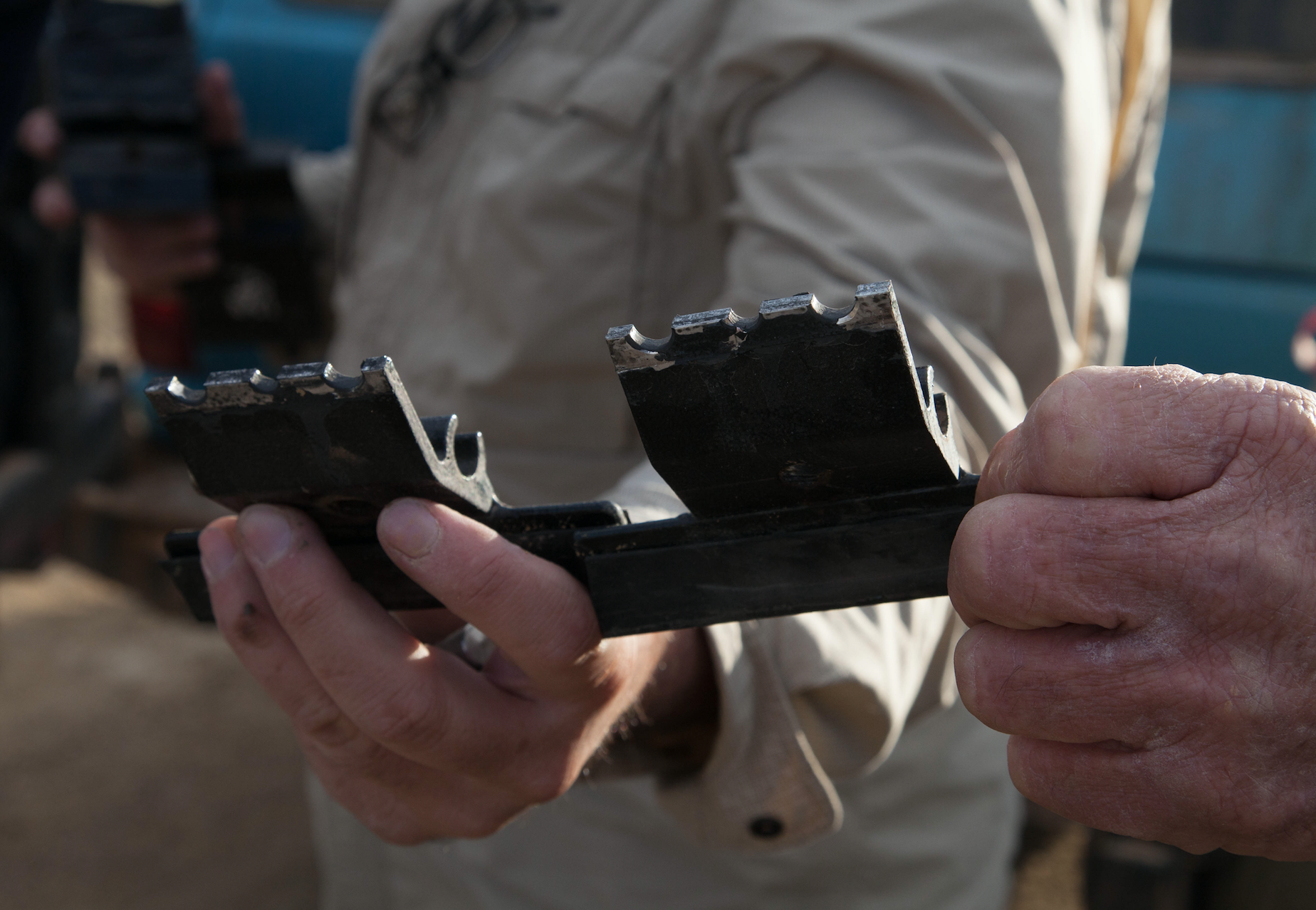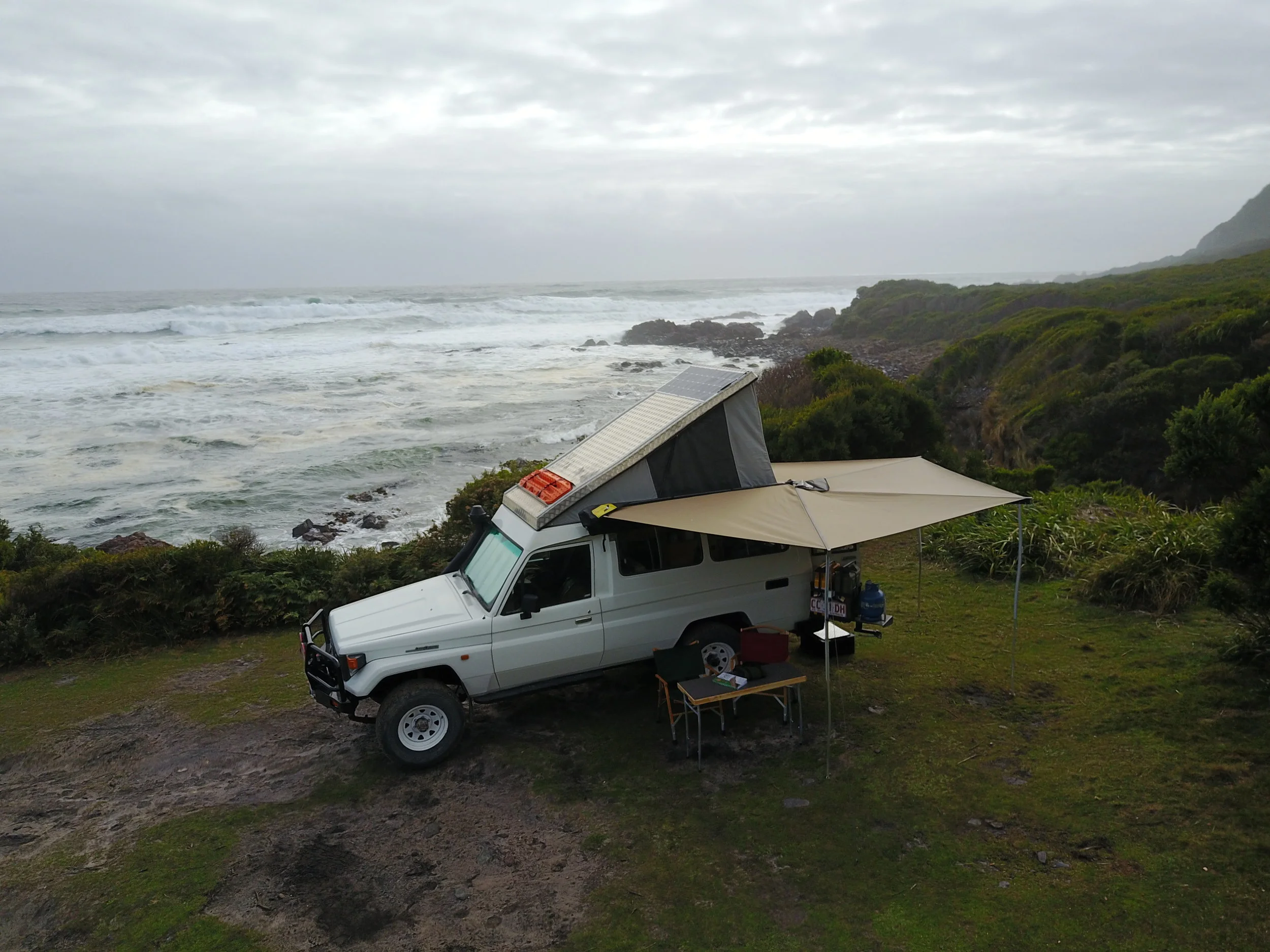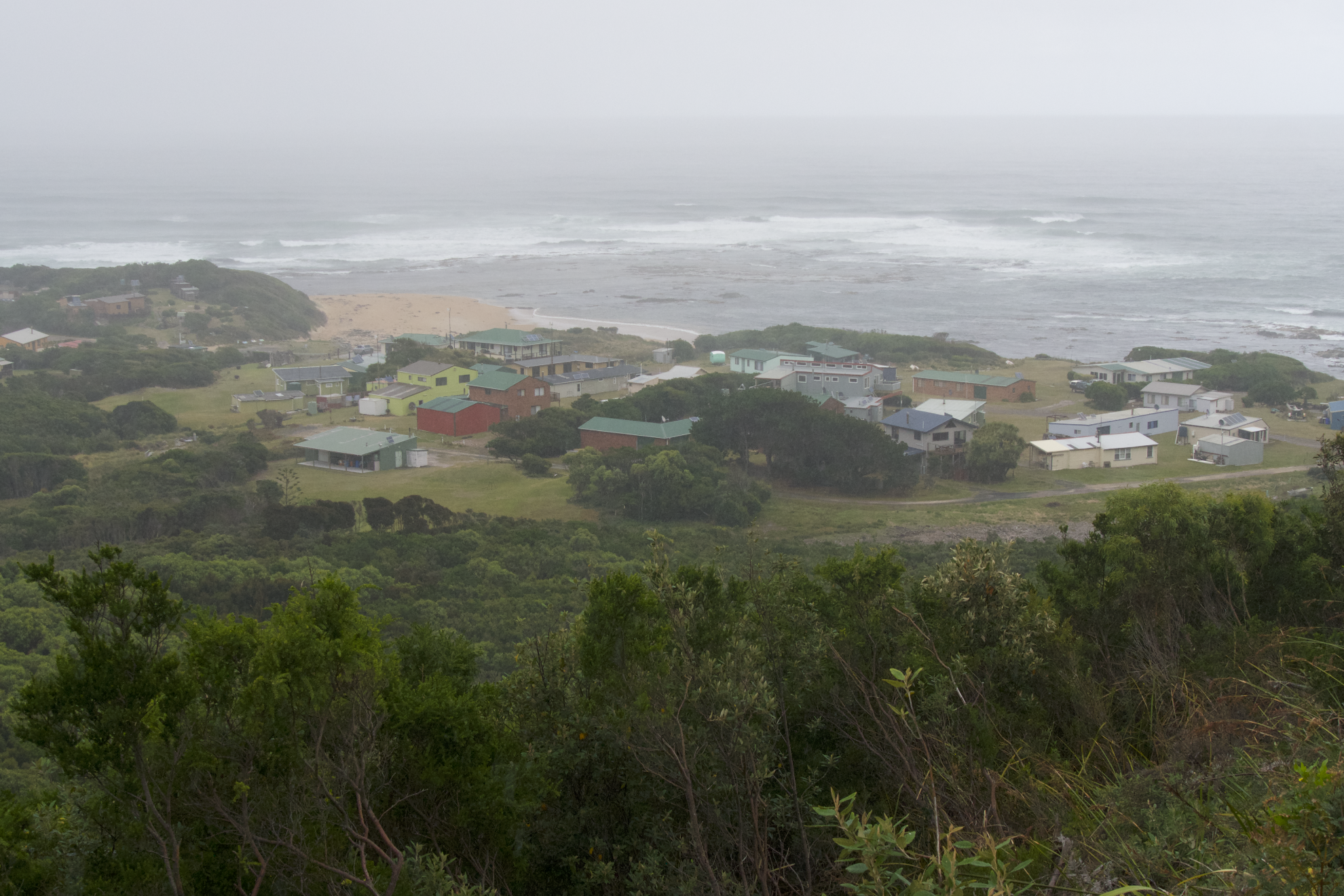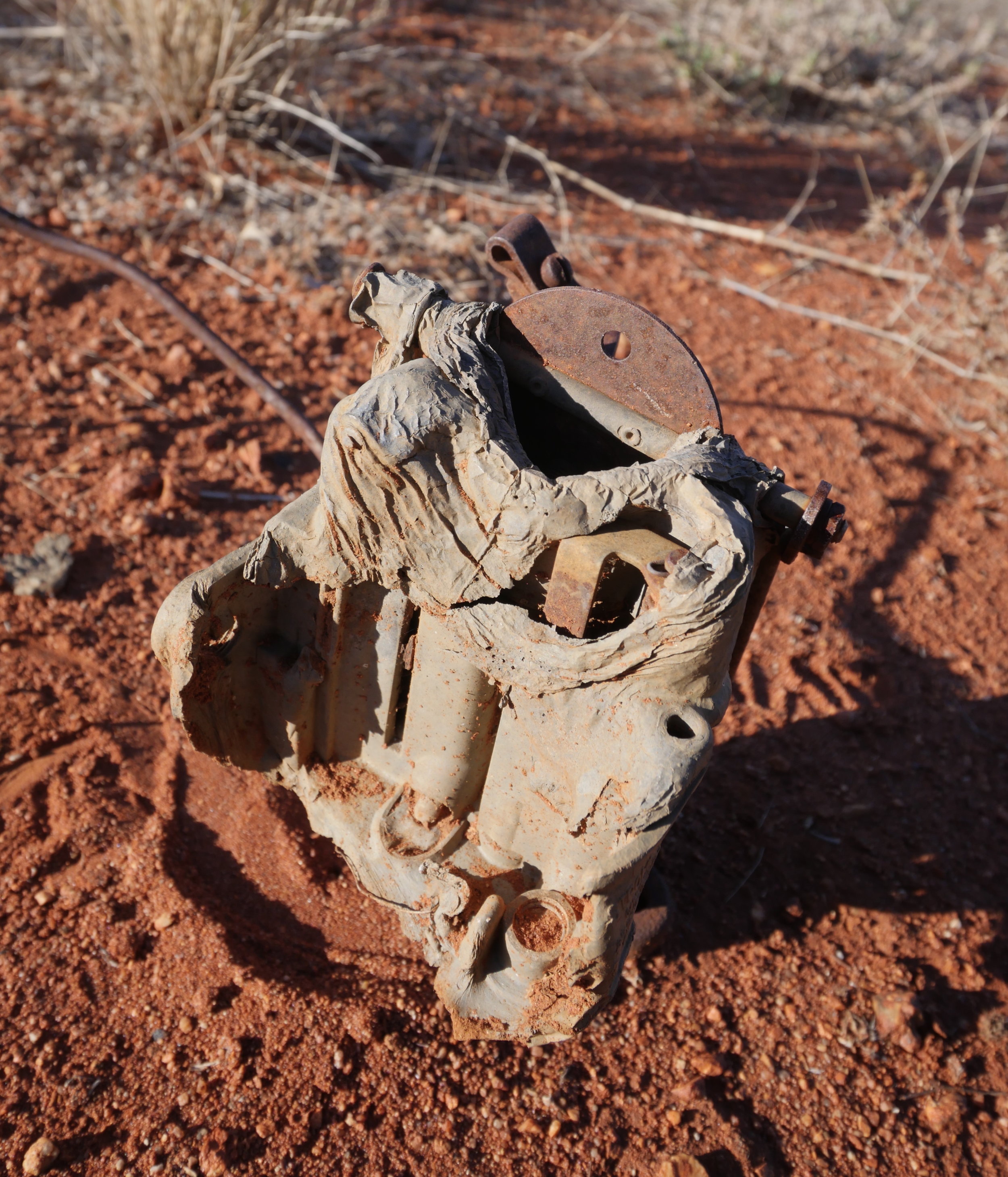If you can’t laugh at yourself, I’ve always said, you should never, ever laugh at anyone else.
So, you think your Zarges cases are stylish?
How about an aluminum-clad explorer’s trunk from Louis Vuitton?
Apparently only a few of these trunks were produced in 1892, and of that few only two known examples survive. This one was recently auctioned by Christie’s for the astounding figure of £160,000 ($206,000). For that price you could buy 412 similarly sized Zarges cases.
But they wouldn’t say Luis Vuitton on the label.
Apparently this one spent much of its life in the UK basement of a family who had no idea of its value.
More here.
Don't be the beta tester
Roof rack brackets broken straight through the adjustment holes
A few years ago my wife and I helped lead a self-drive trip along the U.S. portion of the Continental Divide, the great mountain range that divides North America’s watershed. In addition to our 2012 Tacoma and Four Wheel Camper and the other trip leader’s Ford Raptor, there were a dozen vehicles along, ranging from a pristine late 80s Ford Bronco to a couple of Sportsmobiles, FJ Cruisers, and Jeep Wranglers. Another Raptor and Tacoma, and a recently restored FJ60 Land Cruiser completed the convoy.
Several of the participants had done a lot of last-minute modifications to their vehicle to prepare for the trip, and the FJ60 was fresh off a major rebuild, with some untested components of its own.
It soon began to show.
Climbing through New Mexico, one of the FJ Cruisers pulled off to the side of the trail, and the owner climbed out and began inspecting the custom tire carrier on the back. We stopped and I went over, to find that welds on the carrier were beginning to split, allowing the rack and tire to bang back and forth. We used some ratchet straps to secure the carrier and belay any further cracking—which if left unchecked would have eventually allowed the entire assembly to fall off.
By the Colorado border other issues were surfacing.
A custom auxiliary battery tray on another vehicle began to rattle itself loose. A four-wheel-drive Chevy Van had developed narcolepsy, and would simply stop running for an hour or two, then magically wake up.
A rough trail over a high pass into Wyoming really started to shake things apart. The fenders on a cargo trailer towed by one of the support vehicles—which had been running an easier, parallel course to ours—simply fell off. Another auxiliary battery tray came loose, along with a shock absorber mount.
The FJ60 had a lightweight aluminum roof rack installed, mounted with an Autohome roof tent and a side awning. When the rack started making noise, we inspected it, and found one of the aluminum gutter mounts cracked almost all the way through. That was secured—more or less—with duct tape, and we continued. Then another one cracked, and another. Soon all six mounts were near failing. An inspection showed that, incredibly, the manufacturer—a well-respected South African company—had drilled three adjusting holes in each one right across the area where the most strength was needed. Failure on this part was never a possibility—it was an inevitability.
There was no way to adequately repair the mounts in the field, so at the next rendezvous with the support trucks we took off the entire rack, tent and all, and strapped it on top of the massive welded steel construction rack on the support truck. For the rest of the trip the two guys driving the Land Cruiser had a penthouse suite on an F450.
That Continental Divide trip was an extreme example, but I’ve run into this syndrome time after time after time: A vehicle owner has a much-anticipated trip coming up, and work schedules and budgets dictate a rush of last-minute modifications—many of which are not even really needed, just desired. And out in the real world of washboard trails and rocky hillclimbs it is discovered too late that some of those modifications were under-engineered. In the worst of cases the issues can spell the end of the trip; at best they delay progress and inconvenience traveling companions.
If you have a major trip planned, and a list of things you really want or need to do to your vehicle for that trip, do them enough in advance so you can thoroughly test their quality on shorter excursions. It’s much better to do without an accessory than to find out it is more of a hindrance than an asset. And don’t assume just because something is sold by a famous company that it actually has been proven by them before they sell it to you. Let them do their beta testing on someone else.
Decisions . . .
It was getting late in the afternoon of what had been a long day driving down the west coast of Tasmania. We were exhilarated but looking forward to camp, sundowners, and dinner.
We had two choices. Our map showed a developed campground near Zeehan, just a few minutes away. We’d found these surprisingly nice in Tasmania, with decently spaced sites and good facilities—not bad for a transit stay as we needed. We could be set up and relaxing with plenty of daylight left.
However, the map also showed an intriguing spot on the coast called Trial Harbor, about 25 kilometers down a winding road. But it would add at least an hour to the day, and while our map indicated there was camping available, it gave no further information. We’d have to chance that there would be a spot left.
How often have many of us faced similar dilemmas? It was a close call, but the coast beckoned, so we turned off the C249 and headed west. The road was convoluted but, at first, surfaced, and it immediately dived into a verdant eucalyptus forest. There was a heart-stopping moment when an echidna ambled out in front of us and the Troopy’s brakes—all disc but still less than superb—barely spared the spiny little thing as it did a slow U-turn and waddled back into the undergrowth. Then we broke out into open hills fringed with massive forests blanketing the slopes. The surface turned to gravel, and with zero opposing traffic we wound our way into shaded ravines and out and up again under fast-moving clouds.
The detour had already proven its worth, but then we turned a corner, topped a rise, and beheld the Southern Ocean stretched in front of us, surprisingly only 50 meters below. Whitecaps hyphened the sea into distant windblown salt mist—sail west from here and your next landfall would be Tierra del Fuego; head south and only icebergs would prevent you running into Antarctica.
A sparse scattering of red and green prefab houses clustered behind the breakers—we later learned that Trial Harbor boasts 19 permanent residents. But camping? A hand-lettered sign pointed right. We followed it down a muddy single-track through the brush, spray from waves nearly misting the windscreen. And then there were openings, and a few campers: a Troopy with a pop-top remarkably similar to ours, a Mitsubishi Delica van—and a miraculous open space at the very end of the track, out of sight of anyone. The ocean crashed on to a rocky beach one wrong sleepy step below, and—more miracles—a gin-clear brook tumbled out of the hills just over a rise behind us. Incredulous, we raised the Troopy’s roof, staked out the Eezi-Awn Bat awning, and went looking for where to pay. There was nowhere to pay, just a clean outhouse reached via a charming wooden bridge, and another hand-lettered sign directing us to the “Ringing Rock”—an F350-sized boulder on the beach, decorated with ancient circular Aboriginal carvings, and which, when tapped with a small rock, rang like a metallic gong. (We found out later these are called lithophones, and are know from anthropological sites around the world.)
Back at the Troopy, we had a visit from fellow campers, a hilarious couple of gay Australian men in their 60s, who joked about whose turn it was to play “wife” and wash dishes or fetch water. I broke out the rum and mixed Dark’n’Stormies—appropriate given the setting—Roseann grilled the lamb we’d kept frozen from the superb Springbok’s Delight butcher shop in Sydney, and I played “wife” and washed up before we gazed up one last time at the Southern Cross winking in and out of view behind the clouds. The crashing surf became white noise as we drifted off to sleep.
Before we left next morning, we visited the town’s museum, run by resident Shirley Smith. It was a one-room marvel crammed with photos, memorabilia, and history from Trial Harbor’s early and recent days, along with the occasional curiosity such as the giant sunfish eyeball floating in a jar of formaldehyde. Cost? No cost, just a donation box. We left a lot, then turned the Land Cruiser back up the winding road, taking one last look as the colored houses of Trial Harbor faded into the ocean mist.
The moral of the story? I’m sure you’ve guessed it by now.
Take the road.
Outback mystery . . . or tragedy?
Here’s something I’ve concluded over three trips to Australia and a cumulative 15,000 kilometers or so of driving: Ninety percent of the time, 90 percent of Australia’s great historic tracks are more or less simply very, very long dirt roads that traverse vast expenses of bush and desert—terrain that can be considered strikingly beautiful or forbiddingly barren, depending on your sense of aesthetics. (Count me firmly in the former group.)
All that changes when it rains and many of those tracks become simply undriveable, and a few routes (such as driving east to west on the Madigan Line) require skill and frequent four-wheel-drive use even in optimal conditions, but otherwise such legendary routes as the Birdsville Track can easily be driven in a Subaru Outback—or a Corolla. The world-class corrugations (washboard) you’ll find will test the structural integrity of the stoutest chassis, but your Land Cruiser’s dual lockers and low range will go unused.
With that said, one aspect of travel in central and western Australia has never been exaggerated: It is a very, very remote region. Even on the Oodnadatta Track—one of the most popular routes in the Outback—we sometimes drove for hours without seeing another vehicle. On other tracks, such as the Madigan Line, you can go a week not knowing if all other humans on the planet have been raptured away. So while ultimate capability might not be a critical requirement in your outback conveyance, reliability surely is, along with your ability to repair likely problems if you travel solo.
Tales of epic repairs, jury-rigged and otherwise, abound in outback literature—and video: If you’ve seen Bush Mechanics on YouTube you’ve been exposed to the wackier side of this skill, but real, and sometimes desperate, examples abound.
However, I found myself wondering if the owner of the vehicle whose parts I found in the Australian desert had the skills, and the spare components, to recover it.
We were camped in a wash off Mulga Park Road, actually a renamed section of Australian legend Len Beadell’s Gunbarrel Highway, about 150 kilometers southeast of Uluru (aka Ayers Rock). I was wandering through the scrub with my binoculars in pursuit of a new bird (which, if you’re curious, turned out to be a western bowerbird, a prime find), when I caught a dull glint of metal among the grass. A closer look revealed it to be an ancient single-barrel carburetor—one side of which was melted aluminum slag, the obvious result of a serious engine-compartment fire. The choke plate was locked in place by wrinkled solidified rivulets of non-ferrous metal; where the float bowl had been was an amorphous gray blob. The aluminum base appeared to be fine, leading me to think the fire might have been contained relatively quickly. However, the cast iron throttle plate housing was still attached to the bottom, as was linkage. If my broken-down fellow traveler had access to a spare carburetor I would have thought the ancillary fittings would have been swapped out.
Then the mystery deepened considerably—a few meters away I found an entire rear axle assembly, almost certainly from the same vehicle as the carb, judging by its configuration. Nothing else within a subsequent search circle of 50 meters or more—just an orphaned carburetor and axle from a vehicle at least a half century old, if not much older.
The carb on its own suggested a straightforward breakdown scenario. The addition of the axle left me scratching my head. I’m afraid this mystery will remain one.
What causes those %#@**! corrugations?
. . . or washboard, as they're known (only?) in the U.S. I've been asked this many times, but this time I'll give a nod to the people at Practical Motoring 4x4 in Australia, who explained it perfectly here.
Of course, knowing how they're formed doesn't make them any less infuriating, especially after 40 or 50 unrelenting kilometers of them has loosened every fastener on the truck and every neural connection in your brain, rendering the slightest first-world problem cause for scarlet-faced rage—such as when the iPhone RAM Mount suction cup pops off the windscreen AGAIN and you catch yourself seriously contemplating heaving the whole assembly out the window.
The only defense short of an airlift out by Chinook is to find that sweet spot speed at which the tires are more or less skipping from one crest to the next. It isn't effective enough to use the word relief, but there is a minor lowering of the rage threshold. Beware, however: With the tires in contact with the earth only about 40 percent of the time, the chances for sudden snap-oversteer on a curve or when braking are compounded. And don't think your suspension is getting the relief you are; it's still being punished.
To climb or not to climb . . . Uluru
I'm confident most people reading this will recognize the image above without the need for a caption. Formerly known as Ayers Rock (as christened by William Gosse in 1873 in honor of Sir Henry Ayers, the Chief Secretary of South Australia), it is now preferably referred to by its Aboriginal name, Uluru, bestowed some few thousand years before Europeans chanced upon the 1,100-foot tall (from the base) sandstone inselberg.
We very nearly missed seeing it, fearing the commercialization of the site would spoil it for us. We're glad we decided to go, because the overwhelming grandeur of the place simply crushes any banality humans might tack on to it—besides which we found the visitors' center and associated community extremely well-run, and observantly respectful regarding the deeply held Aboriginal spiritual traditions attached to Uluru.
However. We also uncovered a disturbing controversy.
The local Pitjantjatjara Anangu never climb Uluru, partly because, as I read it, the route to the top crosses a sacred Dreamtime track. Around the site are numerous signs requesting that visitors also refrain from climbing it, both to respect this spiritual tradition and because the people feel responsible when someone is injured or needs rescuing—which apparently occurs with some frequency.
Why not simply ban climbing? Because the 1985 agreement with the Australian government, which finally granted co-management of the rock to the local people, forcibly included a clause that precluded them from doing so. Numerous pleas from them to rewrite the agreement have fallen on deaf ears. As a result, each year several thousand tourists ignore the local beliefs and requests and climb the rock. Some do so simply to say they have; others apparently believe they gain their own special spiritual benefits from doing so. For some even this is not enough—one visitor apparently thought it would be oh so clever to hit a golf ball from the top; a young French woman decided it would be equally clever to have herself filmed running topless along the crest, to be posted on her Facebook page.
More? Sure: There are no facilities on the summit. Many of those climbers who feel their needs are more important than the beliefs of the local people also suddenly feel the need to urinate or worse after their triumphal ascent. When storms deluge the rock with rain, it forms stunning waterfalls, each carrying with it a little something from all those climbers.
Amelie, lovely young French woman at the excellent tribal arts center, informed us of much of this, expressing disgust at the solipsism of her topless compatriot. She also let us know there was a book we could sign, declaring that we had chosen not to climb Uluru in solidarity. We did so proudly.
The Anangu still hope to change the restrictions the government places on their management of their own sacred site. In the meantime, I'll state this: If you visit Uluru and ignore the requests of the local people because you have something to prove, or your shaman told you your spirit would be healed by the magical air on top, and you fall off—I won't shed a tear.
The most interesting Land Rover I ever saw . .
. . . was not the fully kitted double-cab 130 in Namibia, or the 110 pickup veteran of the Rhino Charge in Kenya, or even the ex-Camel Trophy Defender owned by a friend.
It was in the spring of 1986. Roseann and I had been doing surveys to map Harris’s hawk nests in the deserts north of Tucson. We’d driven up Highway 79 to the Gila River area early one morning, and after several hours of glassing for nests stopped to refuel our Land Cruiser in the dusty little town of Florence, whose single claim to fame was and still is the massive state penitentiary on its outskirts. We pulled into a Circle K, and Roseann went in to buy a couple of Cokes while I filled up.
Out of the corner of my eye I saw a vehicle pull in to another pump, and did a double take. It was an ancient Series 1 Land Rover 86—essentially an impossible vehicle to exist in Florence, Arizona, where anything not from the Big Three would have still been looked on even then as deeply suspicious and probably Democrat.
That it was local became apparent when the driver, a craggy 60-ish gentleman, got out, dressed in faded Wranglers, a tattered western work shirt, and a generic feed cap. I walked over and said hi, which he returned in a drawl as thick as gear oil. Yes, he lived there, yes, he’d owned the Land Rover for a couple decades, although, “I can’t remember where it’s made—somewhere in Europe I think.” As I silently gaped at this, he continued, “When I need parts the fellas at the NAPA here get them for me. Never had any trouble with it though.” He raised the hood and started the engine, which ticked away with a barely audible murmer through its oil-bath filter.
The Land Rover was dead original—even the tires looked like they might have rolled it out of Solihull. Winch. Canvas hood. The only additions were a rifle rack and a CB radio.
“That your Tiyota?” He pronounced it tie-ota. Nodded when I nodded. “Mmm-hmm. Nice looking vee-hicle.”
Improbable enough already, but then—look closely at the photo here, scanned from a black-and-white print that is the only record I have of the encounter. See the bottle mounted in front of the windscreen on the driver’s side? Look even more closely and you might spot the pipe leading from it, through the fender, and attached to a fitting on the exhaust pipe.
“That? That’s my gopher getter.” Said with not a little pride.
It turned out that Mr. . . . I never got his name . . . derived a fair amount of his income from eradicating the “gophers”—actually pocket gophers—that plagued the nearby farmers, burrowing up from underneath their crops. The bottle contained some viscous and evil-looking brown poison—I never got its name either—which gravity-fed through the tube and was emulsified in the exhaust stream, whence it was pumped via a hose into the holes of the unlucky gophers.
“My own invention! Kills ‘em real quick. No reason for 'em to suffer.”
I was not sure how he had determined this, but . . .
All the nearby landowners had his phone number as well as his CB handle, he said. Nope, no business name, just . . . whatever his name was. Paid in cash per dead gopher.
After a few more pleasantries, he said, “Well, you take care, young fella. Be seein’ ya.”
But we never did again.
















